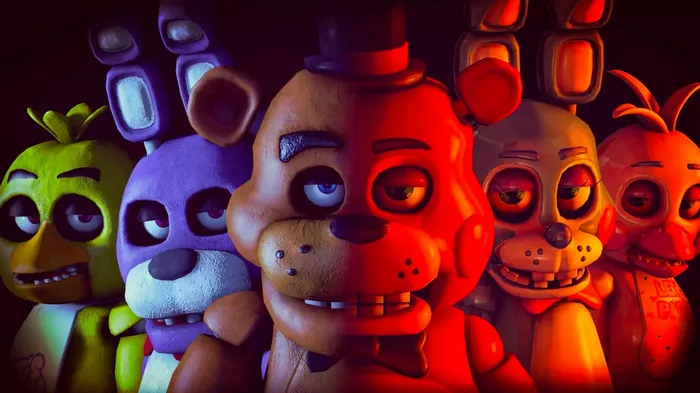A Fandom Ablaze
The world of video game adaptations has always been a tricky territory for filmmakers. Striking the right balance between honoring the source material and making necessary creative adjustments is a challenge. In the case of the highly anticipated Five Nights at Freddy’s movie, the recent backlash surrounding the animatronic designs had fans buzzing with mixed emotions. Creature designer Robert Bennett has stepped into the spotlight to address the concerns, confirming that the designs are not CGI and are intended to stay true to the game’s aesthetics.
An Eye-Catching Debate
The heart of the controversy centered on one particular aspect of the animatronics: their red eyes. The release of the movie’s trailer sparked a heated debate among fans and enthusiasts alike. Some expressed their disappointment at the design choice, feeling that it deviated too far from the game’s original aesthetic. On the other hand, there were those who applauded the bold decision, seeing it as an opportunity to bring a fresh perspective to the Five Nights at Freddy’s universe.
The Game-Accurate Approach
Robert Bennett, the designer behind the animatronics, has now provided some much-needed clarity. In response to the criticism, he confirmed that the animatronics are not CGI creations but rather practical effects. This detail is crucial, as it underscores the production team’s commitment to staying true to the game’s visuals. Bennett’s statement reassured fans that the red eyes are not a result of digital manipulation but a deliberate design choice aimed at achieving game-accurate animatronics.
Mixed Reactions and Disappointment
The red-eye debate in the Five Nights at Freddy’s community revealed a fascinating dichotomy of opinions. Some fans were disappointed by the departure from the game’s established look, feeling that the red eyes were a distraction from the core essence of the franchise. They believed that sticking too closely to the game’s visuals would have been a safer bet. For them, the animatronics’ departure from the familiar was a missed opportunity.
Support for the Red-Eye Aesthetic
Conversely, there were those who championed the red-eye aesthetic. They saw it as a bold and creative choice that added a new layer of intrigue to the characters. The red eyes, in their view, symbolized a darker and more menacing interpretation of the animatronics, potentially enhancing the horror aspect of the film. For this faction of fans, the movie’s willingness to diverge from the game’s visuals was a welcome deviation that promised a fresh take on the familiar.
A Surprising Twist: The Red Eyes’ Removal
Amid the fervent discussions and debates, there was a surprising twist. The removal of the red eyes from the animatronics in promotional materials sparked yet another wave of reactions, this time from fans who actually preferred the original design. Many expressed their disappointment with the change, feeling that the red eyes had added a distinctive and intriguing dimension to the characters. The unexpected backlash against the removal highlighted the complex relationship between fans, filmmakers, and source material.
Balancing Act: Honoring the Game and Creative Freedom
The Five Nights at Freddy’s movie finds itself at the intersection of fandom expectations and creative freedom. Adapting a beloved game franchise to the big screen is a delicate balancing act. Fans often have deeply ingrained perceptions of what the characters and world should look like, and any deviation can trigger strong emotions. On the other hand, filmmakers need the creative space to tell a compelling and visually engaging story that works within the medium of film.
In Conclusion: A Lesson in Adaptation
The debate surrounding the animatronics and their red eyes in the Five Nights at Freddy’s movie serves as a microcosm of the challenges inherent in adapting video games to film. The passionate fanbase’s expectations are both a testament to the franchise’s success and a potential obstacle to creative innovation. Ultimately, the success of the movie may rest on its ability to strike a balance, paying homage to the source material while introducing new elements that make it a unique cinematic experience. As the movie’s release date approaches, fans will be eagerly watching to see how this delicate dance between tradition and innovation unfolds on the big screen. The Five Nights at Freddy’s film is not just about animatronics; it’s about the art of adaptation, and it’s a story that continues to evolve.

